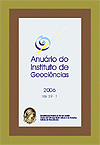Towards an integrated stratigraphy of the Gramame Formation (Maastrichtian), CIPASA quarry, Pernambuco-Paraíba Basin, NE Brazil
DOI:
https://doi.org/10.11137/2006_1_81-94Resumo
This study presents the integrated biostratigraphic (calcareous nannofossils and foraminifera), petrographic, geochemical and ichnological analyzes of the Gramame Formation (Maastrichtian) at the CIPASA Quarry section, in the Pernambuco-Paraíba Basin, northeastern Brazil. A high resolution calcareous nannofossil biostratigraphic study has been carried out, allowing to subdivide the studied section into three subzones of Maastrichtian age: CC25A, CC25B, and CC25C. Each biostratigraphic unit was further characterized by petrographic, geochemical and ichnological parameters. During the Maastrichtian the area was characterized by a dry and warm climate with low influx of terrigenous sediments. These conditions were fundamental to the widespread development of a carbonate ramp system in an outer neritic to bathyal setting, with deposition of alternating calcareous mudstones and argillaceous mudstones of the Gramame Formation. The Gramame Formation belongs to the transgressive system tract of second-order type, characteristic of a Passive Margin Sequence. The studied section consists of part of a third order deposicional cycle, which is arranged in a transgressive systems tract and a highstand systems tract. The lowstand systems tract was not characterized.Downloads
Publicado
2006-01-01
Edição
Seção
Papers
Licença
Os artigos publicados nesta revista se encontram sob a llicença Creative Commons — Atribuição 4.0 Internacional — CC BY 4.0, que permite o uso, distribuição e reprodução em qualquer meio, contanto que o trabalho original seja devidamente citado.
















 Exceto onde indicado de outra forma, o conteúdo deste site é licenciado sob uma licença
Exceto onde indicado de outra forma, o conteúdo deste site é licenciado sob uma licença 